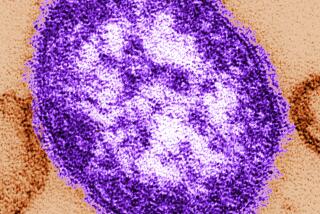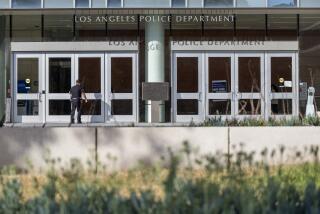L.A. airport police union urges full-body scans at checkpoints
- Share via
The Los Angeles airport police union urged the federal government Monday to begin requiring full-body scans for every passenger at airport security checkpoints, saying metal detectors are no longer enough.
The Christmas Day incident in which a Nigerian man boarded a Detroit-bound Northwest Airlines flight with explosives in his underwear shows that current screening methods are insufficient because they cannot detect material with little or no metal, said Marshall McClain, president of the Los Angeles Airport Peace Officers Assn.
“All available technology and tools must be used to fix an obvious gap in security that puts airline travelers and crew members at risk,” McClain said in a statement. “Testing of whole-body scanners at LAX has shown them to be highly effective in keeping dangerous materials off airplanes.”
The technology, known as millimeter wave imaging, has been in partial use at LAX since April 2008. When it was introduced, critics complained that the technology, which shows through clothing and creates an image of the body, amounted to a virtual strip search.
Peter Bibring, a staff attorney in the American Civil Liberties Union’s L.A. office, said the government should not view the scanners as a “quick technological fix” in the wake of the attempted attack.
“These scanners show starkly detailed images of the human body, which amount to an assault on the dignity of passengers and can be personally humiliating,” he said.
Officials defended the technology, saying measures are in place to protect privacy. The officer viewing the scanned image is in a separate room where no recording devices are allowed, and the image cannot be printed, stored or disseminated, said Suzanne Trevino, a spokeswoman for the Transportation Security Administration. The passenger’s face is also obscured, she said.
There are two scanners in use at LAX, which is one of 19 airports nationwide that use whole-body imagers, according to Trevino. At six of the airports, the scanner is used in lieu of metal detectors. At the other 13 airports, including LAX, it is used as a secondary screening device for passengers who set off the metal detector, Trevino said.
In both situations, the passenger is given the option of being subject to a pat-down search rather than going through the scanner.
Trevino said an aggressive expansion of imaging technology was in the works before last month’s foiled attack. The agency has ordered an additional 150 machines to be delivered early this year and secured funding for another 300, she said. They will be distributed based on risk and to airports that have the infrastructure to accommodate them.
Officials said the imaging is more efficient than pat-down searches. Walking through the machine takes 12 to 15 seconds, whereas a pat-down takes between three and five minutes, Trevino said.
“The bottom line is, we have to be correct 100% of the time, and the terrorists only have to be right once,” McClain said. “After the events of December, it’s definitely warranted.”
More to Read
Sign up for Essential California
The most important California stories and recommendations in your inbox every morning.
You may occasionally receive promotional content from the Los Angeles Times.











